Everyone wants to be comfortable. Unfortunately, that’s easier said than done for people who suffer from sciatica.
When even just sitting down on a chair causes pain, being productive during work hours feels almost impossible.
Should you just push through it and spend six hours sitting in agonizing pain? Obviously, that wouldn’t be very pleasant.
What about standing the whole day? Well, your sciatica may not hurt, but your feet sure would!
But, before you completely give up and quit your job, thinking you’ll never sit comfortably in an office chair, rest assured that there are a few simple things you can do to make sitting comfortable again.
Table of Contents
What is Sciatica?
Sciatica is named after the sciatic nerve, which runs down your leg from your hips and buttox.
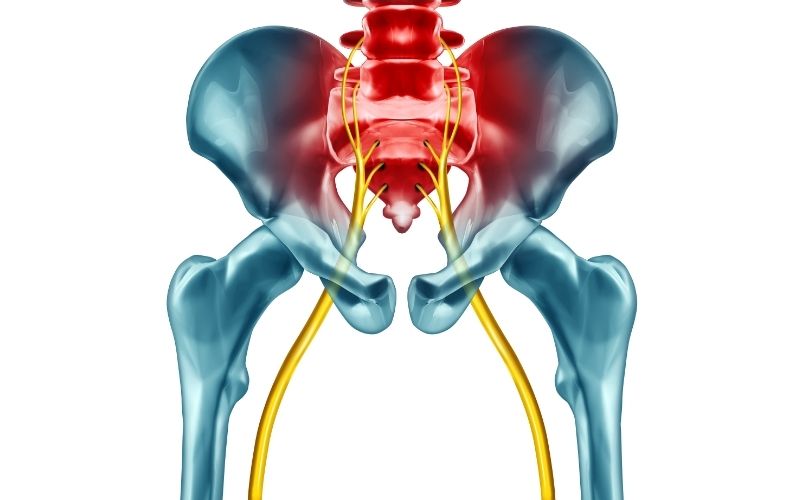
While any nerve damage is painful, the sciatic nerve is the thickest nerve in the body, so the pain is difficult to ignore.
The nerve pain usually happens when a herniated disk, bone spur, or narrowing of the spine pushes on the sciatic nerve. If this happens, you’ll experience inflammation, pain, and/or numbness in the legs.
If you’re lucky, your sciatica will heal itself over the course of a few weeks with treatment. However, some instances are more serious and require surgery.
Because the sciatic nerve runs down your leg, it makes bending to sit painful or uncomfortable.
Is Sitting Bad for Sciatica?
Yes, but that doesn’t mean you aren’t allowed to sit at all!
Sitting too much can cause—or worsen—pre-existing sciatica and should be avoided. This shouldn’t come as too much surprise, though, because prolonged sitting is quite bad for you in general.

In addition to sciatica, long periods of sitting can increase your risk of heart disease, cancer, and type 2 diabetes.
Desk jobs are particularly bad for sciatica because you’ll find yourself getting sucked into your computer while glued to your chair—no matter how comfortable it is.
Sitting puts a lot of pressure on your glutes, lower back, and sciatic nerve. That’s why wearing very tight pants or carrying a lot in your back pockets will also cause similar nerve pain.
As the pressure sits, it can worsen, thus causing sciatic pain or sciatica.
Sitting correctly and putting as little pressure on your sciatic nerve is essential to avoid injury.
How to Sit Comfortably in an Office Chair with Sciatica

There are a few simple tricks to sitting comfortable in an office chair when dealing with sciatica.
It may not feel as relaxed or as comfortable as slouching in your chair with your legs crossed and shoulders hunched, but learning better ways to sit will serve you for life!
Keep Your Legs Uncrossed
The last thing you want to do when sitting is to cross your legs. Ideally, you should never sit with your legs crossed, regardless of whether you’re dealing with sciatica or feel perfectly fine.

When you put one leg over the other, you alter your pelvic position and put pressure on your sciatic nerve, among other things.
Remember, you do not want any pressure! Any position that pushes down on your glutes, lower back, hips, and sciatic nerve will eventually cause issues if you don’t get out of it occasionally.
Crossing your legs can also lead to inflammation, which you want to avoid.
Keep Your Feet Grounded
The sciatic nerve runs through both legs. Think of a jump rope hanging over your pelvis that ends at the bottom of each leg.
With that image still ingrained in your mind, think of the last thing you want to do when experiencing pain in that nerve. Stretching it would be painful and aggravate the nerve, hips, and legs.
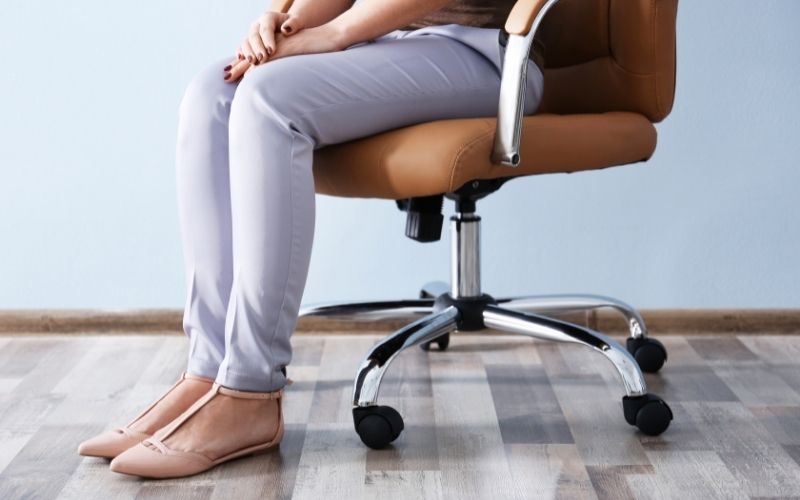
Keeping your feet grounded, or at least ensuring that you never have more than one leg up at a time, ensures that you do not overstretch the sciatic nerve.
You should also be careful not to keep any leg up for too long.
Ideally, you should always be seated with your feet planted firmly into the floor. Not only is this better for sciatica, but it encourages you to sit up straighter.
Make sure to adjust your seat height to make sitting like this easier.
Avoid Turning
Office chairs with wheels are ideal if you’re prone to sciatica.

Twisting and turning is not ideal for your spine or hips, and since the sciatic nerve starts in the hips, this type of movement should be avoided.
If you have a chair with wheels, use it to turn around so that you can keep your hips and spine straight for the duration of the movement. This may be a bit awkward at first, but we’re sure you’ll get used to it.
Just be prepared to be a little patient when turning around to talk to a colleague or grab something from the printer.
Keep Your Knees and Hips Bent
Keeping your knees and hips comfortably bent will ensure you don’t stretch your sciatic nerve too much. Your knees and hips should be bent at a 45-degree angle to reduce sciatica pain.
Be sure to keep them bent while still having your feet planted into the ground for optimal results. Once again, your chair should be low enough, otherwise, this will be difficult.
Sit Close to Your Desk
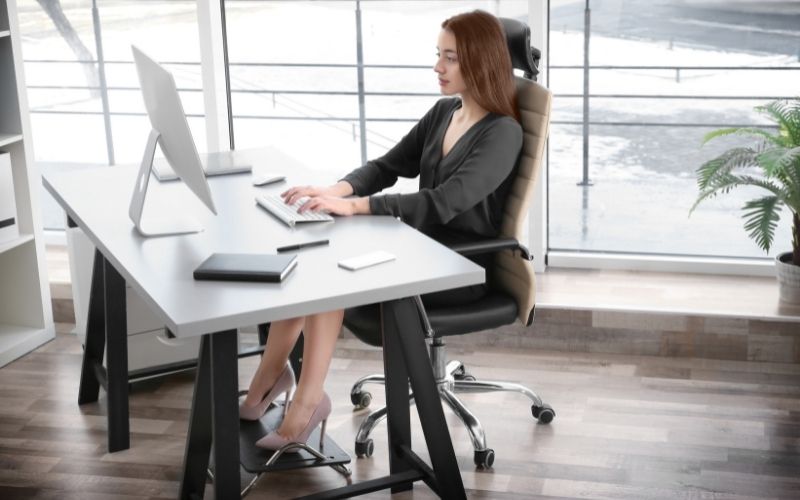
While sitting in your chair properly significantly helps sciatica, it’s not everything. You should also be pulled up closely to your desk, with your work at eye level.
This will keep you from bending over your work or having to reach over to grab things. The key is to avoid unnecessary movements.
Take Breaks
If you have the option to turn your desk into a standing desk, alternate between sitting and standing to keep your hips and legs moving.

If that’s not an option, get up and move around every hour or so to avoid the previously mentioned build-up of pressure in your sciatic nerve.
Good Office Chairs for Sciatica Pain
Now that we’ve gone through what you need to do to get through a day’s work while sitting with sciatica, we’ve compiled a short list of great chairs to help support you and keep you comfortable and pain-free.
WorkPro Quantum Pro 9000
- Upgrade your office setup with this WorkPro Quantum 9000 series executive chair. The convex-shaped back with lumbar...
- Breathable mesh headrest provides support for your head throughout the workday.
- Adjustable height and width arms for upper body comfort.
This ergonomic office chair is easy to adjust to your needs and has a mesh backing to keep your spine gently supported. The waterfall seat cushion means that your legs gently cascade off the edge of the seat instead of abruptly hanging off.
A couple of things to keep in mind is that the armrests don’t pivot, and the backrest will not rock when locked.
Generally, customers are very happy with this purchase. They say that it’s well worth the price and has provided them with sufficient ergonomic support.
GTRACING Gaming Chair
- Perfect for Gaming: Gtracing is dedicated to make the best gaming chair for pro gamers. choose us, and improve your...
- Ergonomic Design: Strong metal frame designed to help promote a comfortable seated position, keeping you comfy...
- Multi Function: Armrest and seat height adjustable;large reclining and rocking; 360°swivel; 5 point base built...
Don’t worry, you don’t need to be a gamer to get this chair. This chair rocks for comfort and comes with a small pillow to hip the nap of your neck for extra comfort.
Gaming chairs are great for people with sciatica because they are designed long periods of sitting and prevent unwanted pressure in the glutes, lower back, and sciatic nerve.
It also comes in a lot of colors, so you can be as bold or discreet with your office space as you want.
SIDIZ T50
- [Million Seller for a Reason] Trusted by multinational companies in 62 countries, T50 desk chair sold 2M units...
- [Dive into Innovative Ergonomics] T50's S-curve design optimally synchronizes and supports your spine. Its modern...
- [Experience Advanced Adjustability] T50 home office chair offers 10+ adjustable functions, supporting your every...
If you’re looking for a modern looking chair with the support you need, the SIDIZ T50 might be the one. Its two-way lumbar support and adjustable headrest and armrests make this chair customizable for practically everyone’s needs.
One thing to keep in mind is that its cushioning is not always enough for people. It’s still a fantastic chair, but we recommend trying it out in-person if possible before ordering it.
What Not To Do With Sciatica
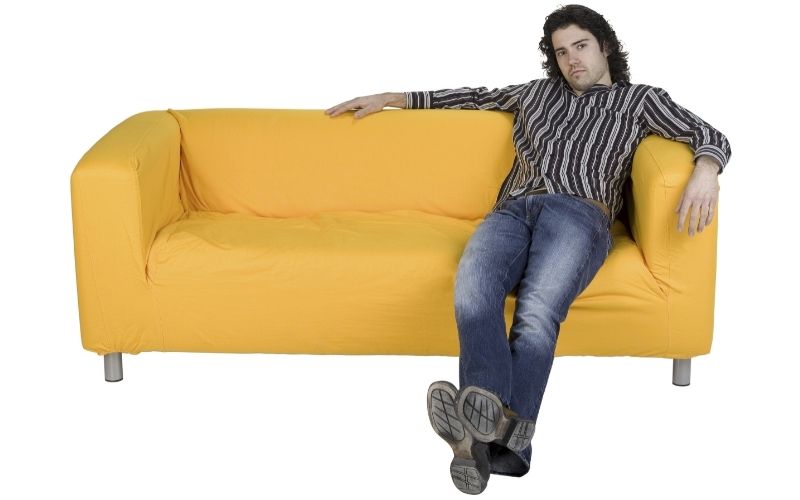
When dealing with sciatica, you should never sit in a chair or on the sofa for prolonged periods of time. Getting up regularly, even if it’s just for a few jumping jacks or to get some water, will help take pressure off your sciatic nerve.
You should also be mindful of the workouts you do when suffering with sciatica. Listen to your body and stop if anything hurts.
Finally, you should not leave sciatica untreated. Always talk to a physician and get the right course of treatment and proper advice.
Other Things You Should Know
There are a few things you can do to help prevent sciatica.
1. Workout Consistently

Keeping your body moving is one of the best ways to stay healthy and happy. A strong back and core will prevent sciatica, so don’t forget to lift a few weights and do a few crunches!
2. Learn to Move Properly
People at risk of sciatica should learn how to treat their body with the patience it needs to not get injured. If you find yourself standing for a long time, alternate putting a foot on a small ledge or box to reduce pressure. Make sure to lift with your knees, not your hips.
3. Good Posture
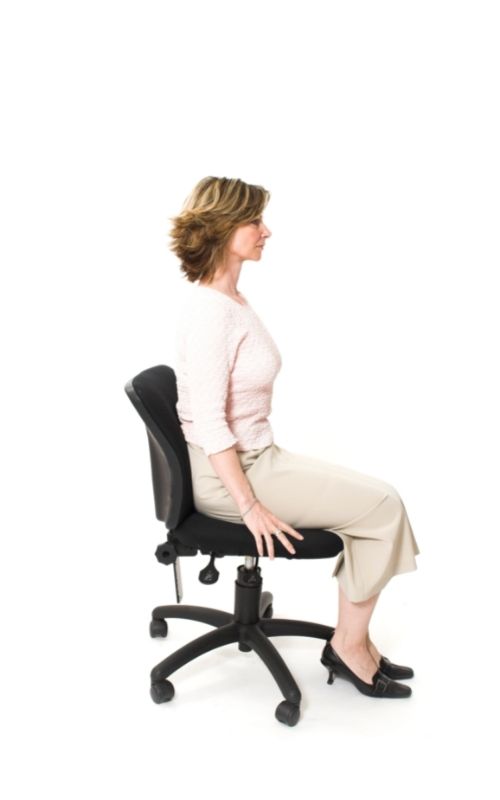
Always be aware of maintaining good posture, especially when you are sitting. This is a great tip even if you don’t have sciatica, and will help you look and feel better in the long run.
In Conclusion
You can sit comfortably in an office chair while suffering with sciatica, you just need to know how to do it properly.
Sciatica can be painful, but it is treatable, and your ergonomic sitting habits can hurt or help your pain and inflammation.
If you’re in need of a new office chair, check out the ones we’ve recommended above. Other customers with similar issues found them supportive and well worth the investment.
What’s your experience with sciatica, and how have you changed your sitting habits to accommodate it? We’d love to hear your thoughts and experiences in the comments!
Good luck!

My name is Vance, and I am the owner of To Ergonomics. Our mission is to improve your workflow by helping you create a supportive and welcoming environment. We hope that you’ll find what you’re looking for while you’re here.




